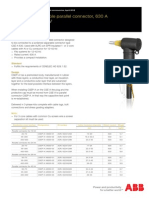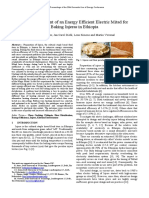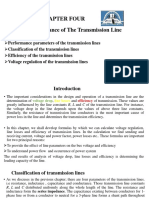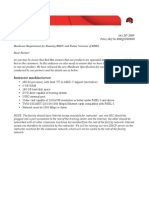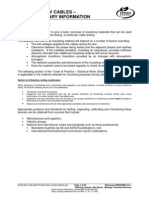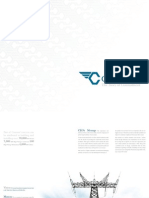Computer Networks Questions & Answers
Computer Networks Questions & Answers
Uploaded by
yatinshraddha1874Copyright:
Available Formats
Computer Networks Questions & Answers
Computer Networks Questions & Answers
Uploaded by
yatinshraddha1874Original Description:
Original Title
Copyright
Available Formats
Share this document
Did you find this document useful?
Is this content inappropriate?
Copyright:
Available Formats
Computer Networks Questions & Answers
Computer Networks Questions & Answers
Uploaded by
yatinshraddha1874Copyright:
Available Formats
www.jntuworld.
com Computer Networks
Questions & Answers
Q1. Explain about Coaxial Cable. Coaxial Cable: Coaxial cable is a common transmission medium. It has better shielding than twisted pairs, so it can pan longer distances at higher speeds. Two kinds of coaxial cable are widely used. One kind, 50-ohm cable, is commonly used when it is intended for digital transmission from the start. The other kind, 75-ohm cable, is commonly used for analog transmission and cable television but is becoming more important with the advent of Internet over cable. This distinction is based on historical, rather than technical, factors (e.g., early dipole antennas had an impedance of 300 ohms, and it was easy to use existing 4:1 impedance matching transformers). A coaxial cable consists of a stiff copper wire as the core, surrounded by an insulating material. The insulator is encased by a cylindrical conductor, often as a closely-woven braided mesh. The outer conductor is covered in a protective plastic sheath. A cutaway view of a coaxial cable is shown in Fig.1.
Fig.1: A coaxial cable. The construction and shielding of the coaxial cable give it a good combination of high bandwidth and excellent noise immunity. The bandwidth possible depends on the cable quality, length, and signal-to-noise ratio of the data signal. Modern cables have a bandwidth of close to 1 GHz. Coaxial cables used to be widely used within the telephone system for long-distance lines but have now largely been replaced by fiber optics on long-haul routes. Coax is still widely used for cable television and metropolitan area networks. Q2. Explain about Twisted Pair. Twisted Pair: Twisted pair is the oldest and most common transmission media. A twisted pair consists of two insulated copper wires, typically about 1 mm thick. The wires are twisted together in a helical form, just like a DNA molecule. Twisting is done because two parallel wires constitute a fine antenna. When the wires are twisted, the waves from different twists cancel out, so the wire radiates less effectively. The most common application of the twisted pair is the telephone system. Nearly all telephones are connected to the telephone company (Telco) office by a twisted pair.
GRIET/ECE
www.jntuworld.com
www.jntuworld.com Computer Networks
Questions & Answers
Twisted pairs can run several kilometres without amplification, but for longer distances, repeaters are needed. When many twisted pairs run in parallel for a substantial distance, such as all the wires coming from an apartment building to the telephone company office, they are bundled together and encased in a protective sheath. The pairs in these bundles would interfere with one another if it were not for the twisting. In parts of the world where telephone lines run on poles above ground, it is common to see bundles several centimetres in diameter. Twisted pairs can be used for transmitting either analog or digital signals. The bandwidth depends on the thickness of the wire and the distance traveled, but several megabits/sec can be achieved for a few kilometers in many cases. Due to their adequate performance and low cost, twisted pairs are widely used and are likely to remain so for years to come. Twisted pair cabling comes in several varieties, two of which are important for computer networks. Category 3 twisted pairs consist of two insulated wires gently twisted together. Four such pairs are typically grouped in a plastic sheath to protect the wires and keep them together. Prior to about 1988, most office buildings had one category 3 cable running from a central wiring closet on each floor into each office. This scheme allowed up to four regular telephones or two multiline telephones in each office to connect to the telephone company equipment in the wiring closet. In 1988, the more advanced category 5 twisted pairs were introduced. They are similar to category 3 pairs, but with more twists per centimetre, which results in less crosstalk and a better-quality signal over longer distances, making them more suitable for high-speed computer communication. Up-and-coming categories are 6 and 7, which are capable of handling signals with bandwidths of 250 MHz and 600 MHz, respectively (versus a mere 16 MHz and 100 MHz for categories 3 and 5, respectively). All of these wiring types are often referred to as UTP (Unshielded Twisted Pair), to contrast them with the bulky, expensive, shielded twisted pair cables IBM introduced in the early 1980s, but which have not proven popular outside of IBM installations. Twisted pair cabling is illustrated in Fig.2.
Fig.2: (a) Category 3 UTP. (b) Category 5 UTP.
Q3. Explain about Fiber optic cables. Fiber optic cables: Fiber optic cables are similar to coax, except without the braid. Fig.3.1 (a) shows a single fiber viewed from the side. At the canter is the glass core through which the light propagates. In multimode fibers, the core is typically 50 microns in diameter, about the thickness of a human hair. In single-mode fibers, the core is 8 to 10 microns. GRIET/ECE 2
www.jntuworld.com
www.jntuworld.com Computer Networks
Questions & Answers
Fig.3.1: (a) Side view of a single fiber. (b) End view of a sheath with three fibers. The core is surrounded by a glass cladding with a lower index of refraction than the core, to keep all the light in the core. Next comes a thin plastic jacket to protect the cladding. Fibers are typically grouped in bundles, protected by an outer sheath. Fig.3.1 (b) shows a sheath with three fibers. Terrestrial fiber sheaths are normally laid in the ground within a meter of the surface, where they are occasionally subject to attacks by backhoes or gophers. Near the shore, transoceanic fiber sheaths are buried in trenches by a kind of seaplow. In deep water, they just lie on the bottom, where they can be snagged by fishing trawlers or attacked by giant squid. Fibers can be connected in three different ways. First, they can terminate in connectors and be plugged into fiber sockets. Connectors lose about 10 to 20 percent of the light, but they make it easy to reconfigure systems. Second, they can be spliced mechanically. Mechanical splices just lay the two carefully-cut ends next to each other in a special sleeve and clamp them in place. Alignment can be improved by passing light through the junction and then making small adjustments to maximize the signal. Mechanical splices take trained personnel about 5 minutes and result in a 10 percent light loss. Third, two pieces of fiber can be fused (melted) to form a solid connection. A fusion splice is almost as good as a single drawn fiber, but even here, a small amount of attenuation occurs. For all three kinds of splices, reflections can occur at the point of the splice, and the reflected energy can interfere with the signal. Two kinds of light sources are typically used to do the signaling, LEDs (Light Emitting Diodes) and semiconductor lasers. They have different properties, as shown in Fig.3.2. They can be tuned in wavelength by inserting Fabry-Perot or Mach-Zehnder interferometers between the source and the fiber. Fabry-Perot interferometers are simple resonant cavities consisting of two parallel mirrors. The light is incident perpendicular to the mirrors. The length of the cavity selects out those wavelengths that fit inside an integral number of times. Mach-Zehnder interferometers separate the light into two beams. The two beams travel slightly different distances. They are recombined at the end and are in phase for only certain wavelengths. The receiving end of an optical fiber consists of a photodiode, which gives off an electrical pulse when struck by GRIET/ECE 3
www.jntuworld.com
www.jntuworld.com Computer Networks
Questions & Answers
light. The typical response time of a photodiode is 1 nsec, which limits data rates to about 1 Gbps. Thermal noise is also an issue, so a pulse of light must carry enough energy to be detected. By making the pulses powerful enough, the error rate can be made arbitrarily small.
Fig.3.2: A comparison of semiconductor diodes and LEDs as light sources Q4. Compare Fiber Optics and Copper Wire. Fiber has many advantages. It can handle much higher bandwidths than copper. This alone would require its use in high-end networks. Due to the low attenuation, repeaters are needed only about every 50 km on long lines, versus about every 5 km for copper, a substantial cost saving. Fiber also has the advantage of not being affected by power surges, electromagnetic interference, or power failures. Nor is it affected by corrosive chemicals in the air, making it ideal for harsh factory environments. Oddly enough, telephone companies like fiber for a different reason: it is thin and lightweight. Many existing cable ducts are completely full, so there is no room to add new capacity. Removing all the copper and replacing it by fiber empties the ducts, and the copper has excellent resale value to copper refiners who see it as very high grade ore. Also, fiber is much lighter than copper. One thousand twisted pairs 1 km long weigh 8000 kg. Two fibers have more capacity and weigh only 100 kg, which greatly reduces the need for expensive mechanical support systems that must be maintained. For new routes, fiber wins hands down due to its much lower installation cost. Finally, fibers do not leak light and are quite difficult to tap. These properties give fiber excellent security against potential wire tappers. On the downside, fiber is a less familiar technology requiring skills not all engineers have, and fibers can be damaged easily by being bent too much. Since optical transmission is inherently unidirectional, two-way communication requires either two fibers or two frequency bands on one fiber. Finally, fiber interfaces cost more than electrical interfaces.
Q5. Explain Switching. Switching:
GRIET/ECE
www.jntuworld.com
www.jntuworld.com Computer Networks
Questions & Answers
Two different switching techniques are used nowadays: circuit switching and packet switching. Here circuit switching is discussed in detailed because that is how the telephone system works.
Circuit Switching: When computer places a telephone call, the switching equipment within the telephone system seeks out a physical path all the way from your telephone to the receiver's telephone. This technique is called circuit switching and is shown schematically in Fig.5.1(a). Each of the six rectangles represents a carrier switching office (end office, toll office, etc.). In this example, each office has three incoming lines and three outgoing lines. When a call passes through a switching office, a physical connection is (conceptually) established between the line on which the call came in and one of the output lines, as shown by the dotted lines. In the early days of the telephone, the connection was made by the operator plugging a jump cable into the input and output sockets. An important property of circuit switching is the need to set up an end-to-end path before any data can be sent. The elapsed time between the end of dialling and the start of ringing can easily be 10 sec, more on long-distance or international calls. During this time interval, the telephone system is hunting for a path, as shown in Fig. 5.2 (a). Note that before data transmission can even begin, the call request signal must propagate all the way to the destination and be acknowledged. As a consequence of the reserved path between the calling parties, once the setup has been completed, the only delay for data is the propagation time for the electromagnetic signal, about 5 msec per 1000 km. Also as a consequence of the established path, there is no danger of congestionthat is, once the call has been put through, you never get busy signals. Of course, you might get one before the connection has been established due to lack of switching or trunk capacity.
GRIET/ECE
www.jntuworld.com
www.jntuworld.com Computer Networks
Questions & Answers
Fig.5.1: (a) Circuit switching. (b) Packet switching. Message Switching: An alternative switching strategy is message switching, illustrated in Fig.5.2 (b). When this form of switching is used, no physical path is established in advance between sender and receiver. Instead, when the sender has a block of data to be sent, it is stored in the first switching office (i.e., router) and then forwarded later, one hop at a time. Each block is received in its entirety, inspected for errors, and then retransmitted. A network using this technique is called a store-and-forward network. The first electromechanical telecommunication systems used message switching, namely, for telegrams. The message was punched on paper tape (off-line) at the sending office, and then read in and transmitted over a communication line to the next office along the way, where it was punched out on paper tape. An operator there tore the tape off and read it in on one of the many tape readers, one reader per outgoing trunk. Such a switching office was called a torn tape office. Paper tape is long gone and message switching is not used any more. Packet switching: The alternative to circuit switching is packet switching, shown in Fig.5.1 (b). With this technology, individual packets are sent as need be, with no dedicated path being set up in advance. It is up to each packet to find its way to the destination on its own. With message switching, there is no limit at all on block size, which means that routers (in a modern system) must have disks to buffer long blocks. It also means that a single GRIET/ECE 6
www.jntuworld.com
www.jntuworld.com Computer Networks
Questions & Answers
block can tie up a router-router line for minutes, rendering message switching useless for interactive traffic.
Fig.5.2: Timing of events in (a) circuit switching, (b) message switching, (c) Packet switching. Packet-switching networks place a tight upper limit on block size, allowing packets to be buffered in router main memory instead of on disk. By making sure that no user can monopolize any transmission line very long (milliseconds), packet-switching networks are well suited for handling interactive traffic. A further advantage of packet switching over message switching is shown in Fig.5.2 (b) and (c): the first packet of a multipacket message can be forwarded before the second one has fully arrived, reducing delay and improving throughput. For these reasons, computer networks are usually packet switched, occasionally circuit switched, but never message switched.
Q6. Compare circuit-switched and packet-switched networks. Circuit switching and packet switching differ in many respects. Circuit switching requires that a circuit be set up end to end before communication begins. Packet switching does not require any advance setup. The first packet can just be sent as soon as it is available. The result of the connection setup with circuit switching is the reservation of bandwidth all the way from the sender to the receiver. All packets follow this path. Among other properties, having all packets follow the same path means that they cannot arrive out of order. With packet switching there is no path, so different packets can follow different paths, depending on network conditions at the time they are sent. They may arrive out of order. GRIET/ECE 7
www.jntuworld.com
www.jntuworld.com Computer Networks
Questions & Answers
Packet switching is more fault tolerant than circuit switching. In fact, that is why it was invented. If a switch goes down, all of the circuits using it are terminated and no more traffic can be sent on any of them. With packet switching, packets can be routed around dead switches. Setting up a path in advance also opens up the possibility of reserving bandwidth in advance. If bandwidth is reserved, then when a packet arrives, it can be sent out immediately over the reserved bandwidth. With packet switching, no bandwidth is reserved, so packets may have to wait their turn to be forwarded. Having bandwidth reserved in advance means that no congestion can occur when a packet shows up (unless more packets show up than expected). On the other hand, when an attempt is made to establish a circuit, the attempt can fail due to congestion. Thus, congestion can occur at different times with circuit switching (at setup time) and packet switching (when packets are sent). If a circuit has been reserved for a particular user and there is no traffic to send, the bandwidth of that circuit is wasted. It cannot be used for other traffic. Packet switching does not waste bandwidth and thus is more efficient from a system-wide perspective. Understanding this trade-off is crucial for comprehending the difference between circuit switching and packet switching. The trade-off is between guaranteed service and wasting resources versus not guaranteeing service and not wasting resources. Packet switching uses store-and-forward transmission. A packet is accumulated in a router's memory, then sent on to the next router. With circuit switching, the bits just flow through the wire continuously. The store-and-forward technique adds delay. Another difference is that circuit switching is completely transparent. The sender and receiver can use any bit rate, format, or framing method they want to. The carrier does not know or care. With packet switching, the carrier determines the basic parameters. A rough analogy is a road versus a railroad. In the former, the user determines the size, speed, and nature of the vehicle; in the latter, the carrier does. It is this transparency that allows voice, data, and fax to coexist within the phone system. A final difference between circuit and packet switching is the charging algorithm. With circuit switching, charging has historically been based on distance and time. For mobile phones, distance usually does not play a role, except for international calls, and time plays only a minor role (e.g., a calling plan with 2000 free minutes costs more than one with 1000 free minutes and sometimes night or weekend calls are cheaper than normal). With packet switching, connect time is not an issue, but the volume of traffic sometimes is. For home users, ISPs usually charge a flat monthly rate because it is less work for them and their customers can understand this model easily, but backbone carriers charge regional networks based on the volume of their traffic. The differences are summarized in Fig.6.
GRIET/ECE
www.jntuworld.com
www.jntuworld.com Computer Networks
Questions & Answers
7. Explain dual cable and single cable systems in broadband coaxial cable. Dual cable: Dual cable systems have two identical cables, cablel1 is used to transmit data (inbound communication) and cable2 is used to receive (outbound communication). A computer that wants to transmit data, it will sent data to cabel1 which is received by a device called the head-end at the root of the cable tree. The head-end then send this data down the tree on to cable2 which is received by the receiver. Fig.7 shows dual cable system. Single cable system: Single cable system has only a single cable but they use different frequency bands to different inbound and outbound communication. Inbound communication from the computers to the head-end uses low-frequency band. In the subsplit system, it ranges from 5 to 30MHz and in the midsplit system it is 5 to 116MHz . The head-end receives the inbound signals, shift them to high-frequency band and transmit over the network. Outbound communication from the head-end to the computer uses high-frequency band.
GRIET/ECE
www.jntuworld.com
www.jntuworld.com Computer Networks
Questions & Answers
Fig. 7 Dual cable system
8. What is the difference between singlemode and multimode fibers in fiber optic networks? Multimode and singlemode are the two modes of propagation of light along optical channels. They differ in physical characteristics of the fiber and the light source. Multimode: Multimode mostly use LED (Light Emitting Diode) as a light source. LED produces unfocused light that enters core at many different places and at many different angles. It is appropriate for short distances as it diffuses over distance. Therefore, in multimode the multiple beam of light from a light source follows different paths in the core. Travelling of beam in the cable depends on the structure of the core. There are two forms of multimode, 1. Step-index multimode fiber 2. Graded-index multimode fiber. Step-index Multimode Fiber In step-index multimode fiber the core and the cladding have different densities. Further, the density of the core is constant from the center to the edges. The beam travels through the constant density in a straight direction. When it reaches at the interface of the core and the cladding, its direction suddenly changes due to a lower density. This sudden change (refraction) leads to the distortion of the signal and hence multiple beams take GRIET/ECE 10
www.jntuworld.com
www.jntuworld.com Computer Networks
Questions & Answers
different paths and hits boundary at different angles. Each angle defines a new path or mode. This is illustrated in fig 8.1
Figure 8.1 Stepindex Multimode Fiber Graded-index multimode fiber In graded-index multimode fiber, the core has varying densities. The center of the core has the highest density and it gradually decreases towards the edge. When the beam travels through the fiber it touches the boundary of the core at different places and at different angles thus giving rise to a curve. However, only the beam travelling through the center of the core travels unchanged. Hence multiple beams give rise to different curves or waveforms as shown in figure 8.2,
Fig 8.2.Graded index multimode Fiber Singlemode A singlemode fiber uses an ILD (Injection Laser Diode) as a light source. The laser produces a focused beam of light that enters the core at small range of angles which is almost close to the horizontal line. Further, the radius of core in singlemode fiber is less than that of multimode fibers. By reducing the radius of core, only a single angle or mode can pass through the core. Thus, the beam of light propagates almost horizontally.
Figure 8.3 Singlemode Fiber The advantage of singlemode fiber over multimode fiber is that the distortion found in multimode cannot occur. Another advantage is that it can be used for longer distances GRIET/ECE 11
www.jntuworld.com
www.jntuworld.com Computer Networks
Questions & Answers
applications such as telephone and cable TV. This advantage comes from the use of ILDs which are more efficient and can achieve greater data rates. 9. Give a comparison of semiconductor diodes and LEDs as light sources. Signalling can be done by using two types of light sources. They are, 1. LEDs (Light Emitting Diodes) 2. Semiconductor diodes. The comparison among the above light sources is as follows, (i) LED has the lower data rate when compared to semiconductor diode. (ii) Mode of propagation of light in LED is multimode whereas in the case of semiconductor diode the mode may be either single mode or multimode. (iii) LED works well only for shorter distances whereas semiconductor diodes can also be used for long distances. (iv) LEDs have longer lifetime compared to that of semiconductor diodes. (v) LEDs are less sensitive to environmental temperature when compared to semiconductor laser diode. (vi) LEDs can be afforded at very low cost than the semiconductor diodes.
10. What are the disadvantages of optical fiber as a transmission medium? Disadvantages: 1. Optical fiber is fragile. As its centre core is made up of glass there are more chances of breaking. 2. Fiber optic cable is very expensive. 3. Maintenance overhead associated with optical fibers is more than twisted pair and coaxial cable. 4. It needs expensive optical transmitters and receivers. 5. It cannot carry electrical power: 6. It is susceptible to fiber fuse at high optical power. Excess Light can destroy several meters per second. 7. Scattering results into losses of light in fiber. 8. Light propagation is unidirectional. A bidirectional communication need two fibers one for each direction.
11. Compare the two methods of serial transmission. Serial Transmission In serial transmission all the bits are transrnitted in a serial manner over a single communication line. Serial transmission can be either asynchronous or synchronous. Asynchronous Serial Transmission: GRIET/ECE
12
www.jntuworld.com
www.jntuworld.com Computer Networks
Questions & Answers
It refers to the process of transmitting bits in an asynchronous manner i.e., without taking the timing constraints into consideration. Instead, both the communicating panics are agreed upon some specific patterns with which a receiver can retrieve information without considering the order in which the bits are transmitted. The agreed upon patterns are based on grouping of hits into bytes, each consisting of 8 bits. As time is not an important constraint in asynchronous transmission, a convention has been followed to alert the receiver about the arrival of a new group in which an extra 0 bit, called the start bit is added a the beginning of each byte and a bit 1, called the stop bit is inserted at the end of the byte being transmitted. As a result of which the size of the byte is increased to 10 bits, of which. 8 hits represent the actual information and 2 bits arc used to alert the receiver. A varying duration is maintained between the successive bytes. This can be represented either by an idle channel or by a stream of stop hits. This method is called Asynchronous because the sender and the receiver need not be synchronized with each other, but within each byte, synchronization is still maintained between the receiver and the incoming bit stream. Advantages: 1. It is cheap and effective. 2. It is a preferred choice for low speed communication. Disadvantage The insertion of start and stop bits and gaps into the bit stream makes it slower than synchronous data transmission. Synchronous Transmission: In synchronous type of data transmission, the incoming bit stream is grouped to form longer frames containing multiple bytes with no spacing between the successive bytes. The bit streams arc then combined to form bytes by the receiver and are used for decoding purposes i.e., the incoming data is sent as an unbroken string of ls and 0s. These strings are separated into the bytes and characters for reconstructing the information. As no start and stop hits and the gap between bytes are available, timing between the successive bytes is critical. This is because the accuracy of the received information is entirely dependent on the ability of the receiver in maintaining the accurate count of the received bits. Advantages: 1. Synchronous data transmission is faster than the asynchronous data transmission because of the absence of start and stop bits and the non availability of the gaps between them. Hence, used for pc-to- pc communication. 2. Byte synchronization can be achieved in the data link layer. GRIET/ECE
13
www.jntuworld.com
www.jntuworld.com Computer Networks
Questions & Answers
Disadvantage Though no separation (gap) is present between the characters, some uneven gaps are available among the successive frames.
12. Discuss in detail about the ISDN system architecture. ISDN Architecture Integrated Services Digital Network (ISDN) is a fully digital circuit switched telephone system. ISDN integrates voice and non-voice services together. The key idea behind ISDN is the use of a conceptual pipe called the digital bit pipe through which bits flow between the customer and the ISDN exchange. The pipe is bidirectional that is the bits can originate at the customer or at the ISDN exchange. Any device such as a digital telephone, a digital terminal, a digital facsimile machine can originate the bits. The digital bit pipe uses time division multiplexing of the bit stream to support multiple independent channels. There are two standards developed for the bit pipe. For home users it defines a low bandwidth standard and for business users it defines a high bandwidth standard supporting multiple channels. Further if the bandwidth requirements of business users are more than provided by a single bit pipe then business users can have multiple bit pipes. The ISDN system for a home or small business is shown below.
As shown in above figure there is a network terminating device NTI placed by the carriers at the customers office and connected to the ISDN exchange using the twisted pair. The NTI has a connector to which a bus cable can be connected. A bus cable can have upto eight ISDN devices such as terminals, telephones and so on. The ISDN system for a large business is shown in figure (2).
GRIET/ECE
14
www.jntuworld.com
www.jntuworld.com Computer Networks
Questions & Answers
Fig 2. ISDN system In this system another device called a Private Branch Exchange, PBX is connected to NTI. It can handle many conversations simultaneously. Both ISDN and non-ISDN devices can be connected to PBX thus it provides the real for terminals, telephones and other equipments.
13. What are the Objectives of ISDN? The main objective of ISDN is to make the telephone system fully digital. The primary goal of ISDN is to integrate voice and non-voice services. The voice services provided by ISDN include, 1. Call transfer and call forward. 2. Display callers information such as phone number, name, address and database record on telephones. 3. Multiple buttons on a telephone for setting up instant call to another telephone. 4. Automatic wakeup call service. The non-voice services provided by ISDN include, 1. Connecting computers in the world as telephones are connected. 2. Provide telemetry services such as remote electricity meter reading, on-line medical, burglar and smoke alarms. 3. Provide teletext services such as composing, sending and receiving c-mails. 4. Access to a remote database for example, on-line telephone book, banking, reservations etc. 14. Discuss in detail the broadband ISDN. ISDN Reference Model:
GRIET/ECE
15
www.jntuworld.com
www.jntuworld.com Computer Networks
Questions & Answers
Broadband Integrated Services Digital Network (B-ISDN) reference model (shown in figure) consists of three layers and three planes. B-ISDN Layers The three layers are. 1. Physical layer. 2. ATM layer 3. ATM adaptation layer.
Fig B-ISDN reference model
1. Physical Layer The physical layer is concerned about the communication channels. It deals with the issues such as voltages, bit timing etc. ATM cells can itself be inserted as payload of other carrier systems, The physical layer is independent of the transmission medium it may be a wire or optical fiber. The physical layer consists of two sublayers PMD and TC. Physical Medium Dependent (PMD) The PMD sublayer is present at the bottom. It does the actual transmission of bits. It turns the bits on and off. It also handles the bit timing. The sublayer is dependent on the cables and carriers. Transmission Convergence(TU) The TC sublayer is present on top of the PMD sublayer. At the sender side, the TC sublayer accepts the incoming cells and break them into a series of bits. This bit stream is GRIET/ECE 16
www.jntuworld.com
www.jntuworld.com Computer Networks
Questions & Answers
then send to the PMD layer. At the receiving side, the TC sublayer takes the incoming bit stream and consvert them into a cell stream to send to the ATM layer. It also tells the begin and end of the cells in the bit stream. 2. ATM Layer The job of the ATM layer is to define the layout of a cell and the transmission of cells. It defines the incoming of header fields of each cell. To transmit cells it establishes and releases a virtual circuit. The ATM also deals with the issues of congestion control
3. ATM Adaptation Layer A layer on top of the ATM layer is ATM Adaptation Layer (AAL). It is provided to allow users to send large packets than a small cell. At the sender side it accepts the packets, break them into cells and then transmit each cell individually. At the receiving end it reassembles the cells the packets. Segmentation And Reassembly (SAR) The SAR sublayer is the lower layer that deals segmentation and reassembly of packets. At one end it breaks the packets into cells and at the other end it builds the packets from the cells. Convergence Sublayer (CS) The CS sublayer is the upper layer that provides different services to different applications depending upon their requirements. For example, the error handling and timing requirements of file transfer and video on demand applications are different. B-ISDN Planes The three planes are, 1. User plane 2. Control plane 3. Management plane. 1. User Plane The job of the user plane is to transmit data and provide flow control, error correction and other user functions. 2. Control Plane GRIET/ECE
17
www.jntuworld.com
www.jntuworld.com Computer Networks
Questions & Answers
The control plane deals with establishing and releasing the connection. 3. Management Plane The management plane consists of the layer management and the plane management.
GRIET/ECE
18
www.jntuworld.com
You might also like
- Bill of Quantity (BOQ)Document2 pagesBill of Quantity (BOQ)Abd Kahah Kasim80% (5)
- Electrical Installation Calculations Volume 1: V. 1: by A. J. Watkins, Chris Kitcher, Christopher James KitcherDocument1 pageElectrical Installation Calculations Volume 1: V. 1: by A. J. Watkins, Chris Kitcher, Christopher James KitcherAli Raza KhanNo ratings yet
- Chapters 5b ExercisesDocument13 pagesChapters 5b ExercisesbibinbibinNo ratings yet
- EEE 805 Assignment Questions For Chapter 20Document11 pagesEEE 805 Assignment Questions For Chapter 20ayeniNo ratings yet
- Electrical Engineering Resume Third Year CombinationDocument2 pagesElectrical Engineering Resume Third Year CombinationБаясааАхNo ratings yet
- Adc PDFDocument62 pagesAdc PDFAkhilesh TewaryNo ratings yet
- Kabeldon Parallel Connector CSEP-A English 2012Document2 pagesKabeldon Parallel Connector CSEP-A English 2012iyilmaz1No ratings yet
- Pat 2 ManualDocument504 pagesPat 2 ManualAngel Dlsg95% (20)
- The Development of An Energy Efficient Electric Mitad For Baking Injeras in EthiopiaDocument8 pagesThe Development of An Energy Efficient Electric Mitad For Baking Injeras in EthiopiaYohannes HaileNo ratings yet
- Datasheet Exhaust Emission VTA28-G5Document1 pageDatasheet Exhaust Emission VTA28-G5hrsciberNo ratings yet
- Final Exam InstallationDocument19 pagesFinal Exam InstallationgteklayNo ratings yet
- Kalid DijoDocument457 pagesKalid Dijoarega amare100% (1)
- CHAPTER NO. 3 - Estimating and Costing of Domestic and Industrial WiringDocument14 pagesCHAPTER NO. 3 - Estimating and Costing of Domestic and Industrial WiringsatyaNo ratings yet
- Lagos City Polytechnic, IkejaDocument1 pageLagos City Polytechnic, IkejaDobgima LangsiNo ratings yet
- Eceg 4401 Electrical Installtion Chapter 2Document25 pagesEceg 4401 Electrical Installtion Chapter 2Kidus AbebeNo ratings yet
- Electrical Installation Test Report - Version2..Document1 pageElectrical Installation Test Report - Version2..Tun NazieNo ratings yet
- Installation Chapter OneDocument16 pagesInstallation Chapter Oneassefa0% (1)
- WiringDocument66 pagesWiringDrHimanshu MalikNo ratings yet
- 8202-031 and 531 Electrical Theory Exam Mark Scheme Summer 2017-pdf - AshxDocument12 pages8202-031 and 531 Electrical Theory Exam Mark Scheme Summer 2017-pdf - Ashxnkxqbwqk22No ratings yet
- CH 1 - Introduction Electrical Installation Design 2010-2011 A4Document10 pagesCH 1 - Introduction Electrical Installation Design 2010-2011 A4Mohd Farkhan Abu BakarNo ratings yet
- GE6162 EPL Lan Manual - ElectricalDocument42 pagesGE6162 EPL Lan Manual - ElectricalDhamu DharanNo ratings yet
- Amen Electrical Technology-Wires & CablesDocument5 pagesAmen Electrical Technology-Wires & Cableslegasu zemeneNo ratings yet
- Electrical Installation Design: Terminology and DefinitionsDocument27 pagesElectrical Installation Design: Terminology and DefinitionsMirkena kebede100% (1)
- 8202-031 and 531 Electrical Theory Exam Mark Scheme Spring 2017 v1-1-pdf - AshxDocument10 pages8202-031 and 531 Electrical Theory Exam Mark Scheme Spring 2017 v1-1-pdf - Ashxnkxqbwqk22No ratings yet
- Diversity Vs Demand FactorDocument3 pagesDiversity Vs Demand Factorajaz8429No ratings yet
- Costing (BQ) CCTVDocument25 pagesCosting (BQ) CCTVapihmarcNo ratings yet
- EarthingDocument44 pagesEarthingArlone Manalad100% (1)
- New Chapter Four LastDocument36 pagesNew Chapter Four LastephremNo ratings yet
- 1 Conduit and Trunking SystemsDocument39 pages1 Conduit and Trunking Systemseffendy00No ratings yet
- 000 EE 153 CAD For EEE PDFDocument35 pages000 EE 153 CAD For EEE PDFStampinusStephanoNo ratings yet
- EBCS 10 Cover FWD Ad Outline RevisedDocument39 pagesEBCS 10 Cover FWD Ad Outline Revisedtesyon korjo100% (1)
- No of Fixture & Lux Level Estimator (10.6.13)Document12 pagesNo of Fixture & Lux Level Estimator (10.6.13)umamaheshwarraoNo ratings yet
- Chapter Four PDFDocument41 pagesChapter Four PDFTebeje TesfawNo ratings yet
- Branch-Circuit, Feeder and Service Calculations, Part III Ele PDFDocument9 pagesBranch-Circuit, Feeder and Service Calculations, Part III Ele PDFNirav PanchalNo ratings yet
- Semister ProjectDocument36 pagesSemister ProjectHaymanot LegesseNo ratings yet
- Service Connection PracticalDocument17 pagesService Connection Practicalbhattparthiv100% (1)
- DG ProjectDocument62 pagesDG ProjectAnonymous 3x7w1Mh7100% (2)
- An Example How To Calculate Voltage Drop and Size of Electrical Cable - EEPDocument8 pagesAn Example How To Calculate Voltage Drop and Size of Electrical Cable - EEPAnil MarturiNo ratings yet
- 7 DEE 1 Domestic Lighting and Power CircuitsDocument15 pages7 DEE 1 Domestic Lighting and Power CircuitsowilbroneNo ratings yet
- Chapter 4 - PresentationeeeeeeDocument79 pagesChapter 4 - PresentationeeeeeeyeabmotherNo ratings yet
- Electrical Distribution SystemDocument21 pagesElectrical Distribution System31Abhinav AkashNo ratings yet
- Electrical Installation Design For (G+6) Urban Building Design /2016Document19 pagesElectrical Installation Design For (G+6) Urban Building Design /2016mengistu AddisNo ratings yet
- Electrical Note 2Document3 pagesElectrical Note 2sofyan_shahNo ratings yet
- ANSI and IEC Standards Based Short Circuit Analysis of A Typical 2×30 MW Thermal Power PlantDocument6 pagesANSI and IEC Standards Based Short Circuit Analysis of A Typical 2×30 MW Thermal Power PlantarifirmansyahtingtingNo ratings yet
- Report DesignDocument81 pagesReport DesignMUHAMMAD MUNIR ASYRAF BIN AB RAZAK STUDENTNo ratings yet
- Cable JointsDocument2 pagesCable Jointsneha061089100% (1)
- Assignment No 4Document1 pageAssignment No 4rajNo ratings yet
- LV SwitchboardDocument11 pagesLV SwitchboardleungyautatNo ratings yet
- Electrical Load EstimationDocument8 pagesElectrical Load EstimationWidhi ImranovichNo ratings yet
- Activity 1 Illumination Engineering DesignDocument2 pagesActivity 1 Illumination Engineering DesignJASPER PAYAPAYANo ratings yet
- How To Design Efficient Street Lighting - (Part-3) - Electrical Notes & ArticlesDocument1 pageHow To Design Efficient Street Lighting - (Part-3) - Electrical Notes & ArticleskakagoNo ratings yet
- Procedure in Installing Electrical Protection SystemDocument17 pagesProcedure in Installing Electrical Protection SystemmaineNo ratings yet
- Electrical Drawing Schematic and LayoutDocument22 pagesElectrical Drawing Schematic and LayoutMulugeta Abrha100% (1)
- Chapter 3 InstalletionDocument38 pagesChapter 3 InstalletionTesfahun LukasNo ratings yet
- Nces 1Document112 pagesNces 1Novic JohnsNo ratings yet
- Table of Content Chapter One: Introduction Electrical Safety Rules Electrical ToolsDocument32 pagesTable of Content Chapter One: Introduction Electrical Safety Rules Electrical ToolsFootkball 1No ratings yet
- Workshop Practice I ManualDocument30 pagesWorkshop Practice I ManualJenberNo ratings yet
- Basic ElectronicsDocument112 pagesBasic ElectronicsoomganapathiNo ratings yet
- Unit 2Document18 pagesUnit 2Sreekanth PagadapalliNo ratings yet
- Physical Layer: Twisted-Pair CableDocument6 pagesPhysical Layer: Twisted-Pair CableNeenu PrasannanNo ratings yet
- Chapter 2 - Transmission MediaDocument15 pagesChapter 2 - Transmission MediaKarthik ReddyNo ratings yet
- Lab 1 of CN by Arslan NadeemDocument11 pagesLab 1 of CN by Arslan Nadeemneymarslan10No ratings yet
- Earth and Life ScienceDocument5 pagesEarth and Life Scienceits mauiNo ratings yet
- JSP Cheat SheetDocument2 pagesJSP Cheat Sheetyatinshraddha1874No ratings yet
- Question Bank For Computer Network (COMPUTER/INFORMATION) PAPER CODE - 12110 ALL 4 Marks QuestionDocument2 pagesQuestion Bank For Computer Network (COMPUTER/INFORMATION) PAPER CODE - 12110 ALL 4 Marks Questionyatinshraddha1874No ratings yet
- Relational Algebra (Iii) : Prof. Sin-Min LEE Department of Computer ScienceDocument55 pagesRelational Algebra (Iii) : Prof. Sin-Min LEE Department of Computer Scienceyatinshraddha1874No ratings yet
- HardwareForRHEL RHEL6ClassDocument3 pagesHardwareForRHEL RHEL6Classyatinshraddha1874No ratings yet
- Core Values & Beliefs of The Best Networkers..Document4 pagesCore Values & Beliefs of The Best Networkers..yatinshraddha1874No ratings yet
- Circular State ServicesDocument5 pagesCircular State Servicesyatinshraddha1874No ratings yet
- Comparison - BIS Code 3034 & NFPA Code 850Document21 pagesComparison - BIS Code 3034 & NFPA Code 850NalinNo ratings yet
- Stringing 30kV LineDocument7 pagesStringing 30kV LineSamuelTrinandoNo ratings yet
- Tes B 106.01Document15 pagesTes B 106.01Badhur ZamanNo ratings yet
- Testing of HV CablesDocument25 pagesTesting of HV Cableslam9021100% (1)
- Zelio Control RM4JA32MDocument8 pagesZelio Control RM4JA32MNikolaBuljaNo ratings yet
- T154 EnglischDocument6 pagesT154 EnglischahmetkocakNo ratings yet
- HM 300Document1,056 pagesHM 300João Guardado100% (4)
- PC350 Prysmian Tech Cable Guide 2010 WebDocument136 pagesPC350 Prysmian Tech Cable Guide 2010 WebPeter Atkinson100% (1)
- 4 Ways in Which Noise Can Enter A Signal Cable and Its Control Part 1Document5 pages4 Ways in Which Noise Can Enter A Signal Cable and Its Control Part 1José SánchezNo ratings yet
- Centaur BrochureDocument9 pagesCentaur BrochuremanohargudNo ratings yet
- Im01c22t02 01eDocument79 pagesIm01c22t02 01essuthaaNo ratings yet
- Assignment No1 Task .No 1Document24 pagesAssignment No1 Task .No 1Faria AmirNo ratings yet
- CV Electrical RandomDocument7 pagesCV Electrical RandomJahan ZaibNo ratings yet
- GIS and Oil Immersed Transformer Terminations: FeaturesDocument4 pagesGIS and Oil Immersed Transformer Terminations: FeaturesSavitha RajitNo ratings yet
- Bomba de Calor MIDEADocument37 pagesBomba de Calor MIDEAaasenjoyNo ratings yet
- Variable-Area FlowmeterDocument15 pagesVariable-Area FlowmeterhotnatkapoorNo ratings yet
- LIT1125 Marshalling Solutions Datasheet v6Document41 pagesLIT1125 Marshalling Solutions Datasheet v6chard serdenNo ratings yet
- 140313143445STANDARDS ElectronicFlyerDocument2 pages140313143445STANDARDS ElectronicFlyerVigiNo ratings yet
- Electrical LV Panel Form ClassificationDocument2 pagesElectrical LV Panel Form Classificationjlcheefei9258100% (1)
- Design Methodology For Undersea Umbilical CablesDocument9 pagesDesign Methodology For Undersea Umbilical CablesAlaeddineNo ratings yet
- Establishing GPR and ZOIDocument18 pagesEstablishing GPR and ZOILong LeoNo ratings yet
- Web HPC 804Document2 pagesWeb HPC 804api-30194194No ratings yet
- 285-30 Switch SumergibleDocument18 pages285-30 Switch SumergibleVictorForcadellNo ratings yet
- Inversor Micromaster 6SE31 MM2 DTR enDocument50 pagesInversor Micromaster 6SE31 MM2 DTR enluispipoco0% (1)
- Anchor Chain Cable Drydock InspDocument20 pagesAnchor Chain Cable Drydock InsprajishrrrNo ratings yet
- Wire Cable Methods of Color Coding PDFDocument4 pagesWire Cable Methods of Color Coding PDFAnonymous rAFSAGDAEJNo ratings yet
- st60 Wind Manual PDFDocument52 pagesst60 Wind Manual PDFDave WinwoodNo ratings yet






